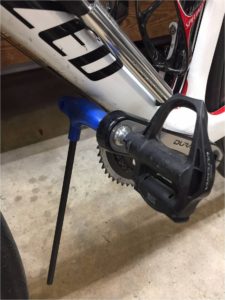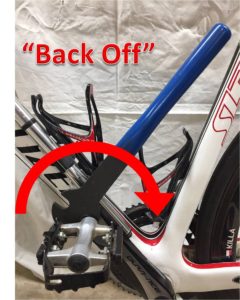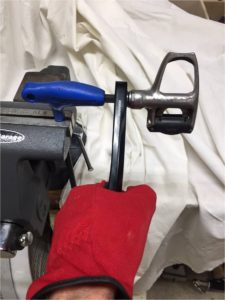Forty three years ago I worked a summer as a roustabout on an oilfield work gang. A large part of my job those months was operating a 48” pipe wrench to tighten and loosen threaded connections of all sorts. The senior guys on the crew watched me struggle for a few days (to build character, I guess) before sharing their “secrets”. Some of what they taught me is not applicable to bicycle mechanics, like beating on a corroded flowline thread with a sledge hammer to loosen it. But a lot of the principles of wrangling threaded connections apply.
Bicycle pedals are notorious for being hard to remove. One reason is that they self-tighten as you pedal. This is a good thing – they tend not to fall off. This is why the left pedal has a left-hand thread. Unfortunately this self-tightening effect, along with a bit of corrosion, can make them very difficult to remove, even if they were not over-tightened during assembly.
It gets worse. Many manufacturers have eliminated the wrench flats to shave off a few grams. A 6mm or 8mm allen key must be inserted into the end of the spindle. Try getting any leverage in this position!
Over the years I have attacked a lot of stubborn pedals, and I have learned some tricks that have enabled me to remove pedals that no one else could.
1. Always wear work gloves when removing pedals to prevent busting your knuckles. In fact, there are lots of times in the garage when work gloves are appropriate. Don’t be macho. It’s also a good idea to shift the chain onto the big chainring to cover the teeth, but busting your knuckles on the chain is no fun either.
2. Use the mnemonic “Back Off” to remember which way to turn to remove pedals. It works for both sides, and keeps me from getting confused, especially when approaching a pedal from the opposite side with an allen wrench. Just rotate the wrench toward the back of the bike to remove the pedals.
3. For seriously seized pedals remove the cranks from the bike, clamp your pedal wrench or allen wrench in a bench vise, and use the crank arm as your lever. Think real hard about which way to turn the crank arm in this scenario.
4. My last resort is using a hair dryer or heat gun to loosen the threads. Aluminum expands more in response to heat than steel or titanium*. The inside diameter of the hole in the crankarm grows faster than the outside diameter of the pedal spindle, loosening the thread. This works on carbon fiber cranks too, because there is an aluminum insert into which the pedal threads are cut. But be very careful heating carbon fiber cranks. A good rule of thumb is if you can’t hold it in your hand for five seconds, it’s too hot.
Here are a few other thoughts that come to mind:
A pot of hot water may be an effective heat source, and safer for carbon fiber. Configure a way to heat the crank and chill the spindle, and you should really loosen things up.
It’s easier to apply torque with the bicycle on the ground than with it hanging on a rack.
Arrange your wrench so you can push down rather than pulling up. Use your weight.
Assume the wrench is going to slip and be prepared for what will happen when it does.
I find penetrating oil is not especially effective on aluminum corrosion. I’d appreciate suggestions. Any chemists out there?
I know that when you’re fighting to remove a recalcitrant pedal it’s a little late, but apply some heavy grease or anti-sieze compound to pedal threads before assembly.
I was discussing this topic with my scientist friend Pierre. If pedaling forwards tightens pedal threads, it is possible that pedaling backwards with sufficient exuberance will loosen them. The trick is somehow to maintain significant weight on each pedal throughout the crank rotation. (Hang a hundred pound weight on one pedal while your biggest strongest friend grabs the other pedal and cranks backwards by hand?)
Regarding pedal disassembly: Just as the thread between the pedal and the crank arm is left-handed on the left side, some of the threads used to hold pedals together are left-handed. Check the service instructions, or at least try loosening in both directions before getting rough with it. Personally I use cheap enough pedals that if they need internal service I just throw them away and get a new pair.
By the way, bottom bracket threads on the right side are left-handed (except for the obsolete Italian and French standards), for the same reason the left pedal thread is left-handed – to be self-tightening (except for the obsolete Italian and French standards which are self-loosening.) Obviously the various and sundry press-fit bearing evolutions are not threaded at all.
Look through www.RoadBikeRider.com issues 745 and 746 for more discussion on pedal care, where you will find some of my recommendations as a comment to Jim Langley’s articles. You can also sign up to receive Road Bike Rider as a free weekly e-mail newsletter covering lots of cycling topics.
Now get out there and self-tighten those pedals!
Killa
* For the engineers in the crowd, the coefficient of thermal expansion (CTE) of aluminum is approximately 22 (10-6 m/(m K)). Steel is about 12. Titanium is about 9. The CTE of carbon fiber varies from 2 to 14, depending on weave, resin content, and direction of measurement.


